Sailing a kayak
Downwind is easy. Do you just want a simple little aid to cruising which you take out of a bag, set up in two minutes on the water and then ignore as it pulls you gently downwind? There's a lot to be said for it. Sea kayaks are designed to go at speeds up to about 5 knots. If you go much faster, things start to disappear in a cloud of spray.
Upwind sailing takes more thought and money. Do you want to turn your kayak into a micro-multihull, even if it means sacrificing portability, simplicity and ability to recover from a capsize?
Simplest rig - straight downwind only
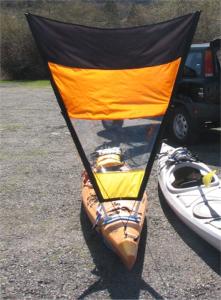 Up to 5 knots a sea kayak is efficient and comfortable. A kayaker applies a force of about 6 to 12 pounds with each stroke of the paddle, and a peak force of over 35 pounds when punching out through surf. However a constant pull of only 3.5 to 5 pounds is enough to move the typical sea kayak through the water at 4 to 4.5 knots. Even a tiny sail or kite is enough, and if you're happy to go more or less directly downwind you don't need a rudder.
Up to 5 knots a sea kayak is efficient and comfortable. A kayaker applies a force of about 6 to 12 pounds with each stroke of the paddle, and a peak force of over 35 pounds when punching out through surf. However a constant pull of only 3.5 to 5 pounds is enough to move the typical sea kayak through the water at 4 to 4.5 knots. Even a tiny sail or kite is enough, and if you're happy to go more or less directly downwind you don't need a rudder.
North American Indians who had to cross a lake with the wind behind them would sometimes load a small bush into their canoe and just hold it up to catch the wind.
The modern equivalent is a purpose-made downwind sailing rig like the one on the left. They're used quite often with wide, stable sit-on-top kayaks. To use one with a 20-inch wide sea kayak you'd probably need to raft up with somebody, but some paddlers do use a 15 square foot sail on a classic sea kayak, on the open sea with no stabilizer.
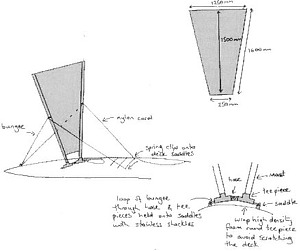 I'm pretty sure the rig in the picture was made in Oregon, based on Rebecca Heap's 2002 design. Rebecca said it was "guaranteed to make your kayak go like a rocket downwind up to 40 degrees either side! ... There are about 60 of these sails in use in Auckland and there have never been any near misses or nasty accidents." Click the diagram to go to her instructions, and there's more on this kind of sail at Mike's Kayaking Adventures.
I'm pretty sure the rig in the picture was made in Oregon, based on Rebecca Heap's 2002 design. Rebecca said it was "guaranteed to make your kayak go like a rocket downwind up to 40 degrees either side! ... There are about 60 of these sails in use in Auckland and there have never been any near misses or nasty accidents." Click the diagram to go to her instructions, and there's more on this kind of sail at Mike's Kayaking Adventures.
If you'd rather buy a ready-made rig, Windpaddle make a bowl-shaped downwind sail for sea kayaks. It stores as a flat disc on your front deck, but when you give it a flip of your wrist it opens up like one of those self-erecting tents to be 42 inches across. See Retail Outlets.
Alternatively you could take advantage of the stronger winds 100 feet up by flying a basic, stable non-steerable kite. Raft up with a friend for stability, send up a small kite and relax as you go gently downwind. If you follow a kite too fast it will fall out of the sky. You can either trail something behind your kayak to create drag, or steer with a paddle or rudder so that you go slightly right or left.
Parafoil kites, illustrated below, are inflated to an efficient wing shape by air which is constantly rammed into the leading edge. Some sleds and most parafoils need no spars, so a small one like the Peter Lynn Pocket Sled will literally fit in your pocket. You may find that a small kite, just a children's toy of less than 5 square feet, is enough. The wind is a lot stronger and more stable 100 feet up. If you want more power for your downwind kiting, try a larger kite. You can get a parafoil up to 15 square feet for a reasonable price.
Box kites were issued to flight crews during the Second World War so that if they crashed into the sea, they could use them to take up a radio aerial from the liferaft. Box kites need only one line and they are so stable that they need no attention when they are up, but they do need spars (rigid sticks) to keep their shape so they are a little awkward to stow in a kayak. Other possibilities, available online or from beach toy shops and requiring only one line to fly, include the Sutton Flowform manufactured by Air Affairs of Pennsylvania; small Rogallo wings (parawings); or small sled kites which may have two spars or none.
Small, simple rig - downwind but with more directional control
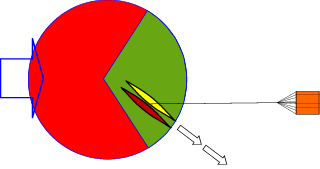 |
If you hang a small plywood leeboard over the side of your kayak, you have more control over your downwind course.
Your direction depends where, along the length of your kayak, you attach the leeboard and how far in front of the centerline of the leeboard you hold your kite line. You probably won't be able to go any more than 60 degrees off the wind, but you can choose to sail on any course within the green sector which is 120 degrees wide. It's easier if you have a rudder as well as a leeboard. |
In 1987, Ed Gillett paddled and kite-sailed a Necky Tofino double kayak 2200 miles from California to Hawaii in 64 days. The wind was behind him most of the way, and for about 60% of the time he flew a Jalbert J-15 kite (a 15 square foot single-line parafoil) which added about 2.5 knots to his speed.
More complex, heavy rig - upwind too
A sailboat can't go directly upwind but it can maintain a course within 45 degrees of it and make real progress to windward by zig-zagging (tacking). The closer to the wind you steer, the more your sail tries to capsize you (heeling). You need some sort of stabilizer to sail upwind. Sailors deal with this in three ways. A dinghy sailor shifts his or her weight further and further upwind, often right over the side of the boat until his or her backside is dragging in the water. A yachtsman attaches a heavy weight (half a ton of lead) to the bottom of the boat. A multihull sailor attaches a rigid spar across the hull at right angles and attaches a float to the downwind end. The spar is called a crossbeam or iako; the float is called an outrigger or ama. Usually there is an ama on each side of the main hull. A handful of techy sailors use hydrofoils instead of floats.
Also, the closer to the wind you go the more your sail tries to push you sideways, downwind (leeway). To resist this, you need a vertical fin hanging down into the water. A sailing dinghy has a slot in the center of the hull down which the sailor thrusts a daggerboard, as with the International Laser, or which contains a centerboard which the sailor can pivot downwards when going upwind. That sort of fin has the additional advantage that when you make a sharp change of course, the boat pivots instantly round the fin. A beach catamaran relies on having hulls with a sharp underwater cross-section.
A kayak or canoe can be temporarily fitted with leeboards, a pair of wooden planks which hang vertically over the side. Only one is in the water at any time, always on the downwind side of the boat. The force of the wind pushing the boat sideways keeps the leeboard vertical and in position by pressing it against the side of the hull.
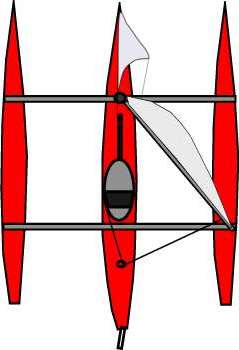 Getting back to stabilizers, some manufacturers have produced kayaks fitted with a pair of outrigged floats. The red one is about as heavy and complex as these get. It has a pair of long, rigid floats (ama), a pair of long, strong crossbeams (iako), a rudder and centreboard, a fairly tall stiff mast, and a sophisticated sailing rig. It's really a miniature trimaran. If you want to build one, you can get plans from designers like Kurt Hughes, Chris Ostlind, Mark Gumprecht or Ray Kendrick, or maybe buy a kit from Chesapeake Light Craft (CLC).
Getting back to stabilizers, some manufacturers have produced kayaks fitted with a pair of outrigged floats. The red one is about as heavy and complex as these get. It has a pair of long, rigid floats (ama), a pair of long, strong crossbeams (iako), a rudder and centreboard, a fairly tall stiff mast, and a sophisticated sailing rig. It's really a miniature trimaran. If you want to build one, you can get plans from designers like Kurt Hughes, Chris Ostlind, Mark Gumprecht or Ray Kendrick, or maybe buy a kit from Chesapeake Light Craft (CLC).
A simpler, cheaper solution is to use an unmodified sea kayak as the main hull and add a couple of rigid ama, as in the picture at the top of this page. You can buy a mini-trimaran from French kayak manufacturer Plasmor which uses their Belouga kayak as the main hull, and at least one US manufacturer (Easy Rider Kayaks) sells equipment which enables customers to turn two of its sea kayaks into a catamaran with a powerful sailing rig and twin rudders. With a small sail rig, say up to 45 square feet, you and your partner can glide along dry and lazy while sitting in your cockpits. And with a 90 square foot rig you could, at the cost of leaving your cockpit in order to balance the boat with your weight, sail rings round your local racing dinghy fleet.
If you want to make your own rigid ama and iako, plans are available from Chesapeake Light Craft. At the time of writing you can buy the large-scale plans for $69 from CLC or get free small-scale plans by ordering the July/August 1996 of WoodenBoat magazine (issue no. 131) from www.woodenboatstore.com. Contact details for Plasmor and CLC are at Retail Outlets.
Any sort of rigid ama is still too heavy and too complex for a lot of people, who prefer a lightweight sailing kit which can be carried inside a kayak and which folds, clips and inflates to make a sailing rig. Kits consist of a mast; sail; control rope; a pair of inflatable floats; a leeboard; a cross-beam and brackets to attach it to the kayak; and a rudder. With a rig like this a kayak can tack upwind. It will be too light and wet to make a really good sailing boat on a windy day, but the kayaker sits so low that he has a great impression of speed. Especially if he sails through a steep wave. Kayakers using rigs like this have made some long expeditions under sail, including one through the North West Passage at the top end of Canada. (Sailing a small open boat in the Arctic must be absolutely freezing... at least paddling keeps you warm!). See Balogh Sail Designs at Retail Outlets.
We mention the Windyak, Bruce foils, the SkiSail and the Triak at Other Multihulls For Exposed Waters.
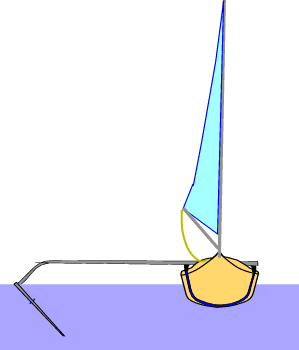 It is possible to substitute hydrofoils for floats.
It is possible to substitute hydrofoils for floats.
Chris Hare, an English pioneer of Greenland kayaking, designed a commercial version for kayaks called the K-Wing, shown here in cross-section:
This included a lightweight iako which could quickly be attached to any sea kayak with a couple of straps. The iako extended out to one side and had a surface-piercing foil on the end. We have never seen it demonstrated in rough water or gusty winds but it is said to have worked very nicely with a small mast, sail and rudder.
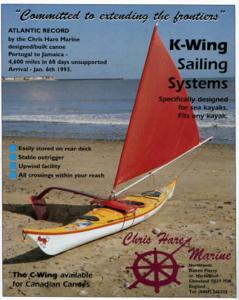 To make it light and small enough to fit on the rear deck when not in use, the K-Wing had a foil on only one side and the foil had no significant flotation. Flotation is definitely worth having because in the chaotic conditions of the boundary between air and water, a Bruce foil will eventually either sink or get plucked up out of the water. The problem in a kayak is finding a way to stow a foil if it's fitted with positive buoyancy.
To make it light and small enough to fit on the rear deck when not in use, the K-Wing had a foil on only one side and the foil had no significant flotation. Flotation is definitely worth having because in the chaotic conditions of the boundary between air and water, a Bruce foil will eventually either sink or get plucked up out of the water. The problem in a kayak is finding a way to stow a foil if it's fitted with positive buoyancy.
According to the manufacturer's publicity, if you made a "fast, tight right hand turn when the wing is at the centre of the turn and [therefore] stationary... it will sink alarmingly, but as soon as the kayak [starts moving in the new direction] it will climb back to the surface". The K-Wing is now out of production.
Like the wing of an aircraft, a hydrofoil provides lift only as long as it is moving. Let's say you have a kayak stabilized by a single foil, out to your right. If you turn right quickly, the foil may well be stationary in the water, leading to a capsize. Also, the sea is a pretty unpredictable place. If you are hit by a gust of wind from the right, your stabilizer may pop out of the water. Another instant capsize. For this reason, foil stabilizers tend to have some built-in flotation, either foam or inflatable, for when they aren't moving or the unexpected happens. Consider the original Triak - it did have hydrofoil stabilizers, but these were attached to buoyant amas about 5 feet long. It seems the foils were more trouble than they were worth, because in later models they have been dropped and the amas have increased in size to nearly 8 feet long, so the Triak is now a miniature trimaran.
Sail or kite
A sail needs a mast. When the sail is working, some of the wind's energy goes into pushing the boat forwards but some pushes sideways against the mast, which acts as a lever and tends to capsize the boat downwind. A kite does not need a mast and has less tendency to capsize an unstabilized hull. However kites for upwind sailing are quite demanding.
Small modern sailing boats almost inevitably have a triangular Bermudan / Marconi sail. Efficient Bermudan sails have a high aspect ratio which means a tall, heavy, expensive mast that has to be kept upright by permanent wire rigging attached to the bow and the sides of the hull. Sailing canoes like Yakaboo often have a batwing rig where semi-rigid battens are used to make a lower sail with a shorter mast but the same area. Bermudan and batwing sails function like an aircraft wing thanks to a surface which is curved in three dimensions. That means they have to be assembled by sewing together several precisely cut pieces of cloth.
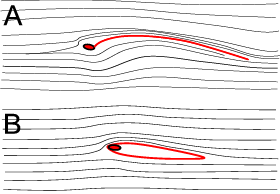 A conventional single-surface sail (A) functions like a kite or hang-glider wing.
A conventional single-surface sail (A) functions like a kite or hang-glider wing.
For more power and less sideways pressure, you could use a lightweight wing-sail (B) which has two sailcloth surfaces. The mast is between them rather than outside where it can disrupt airflow. The wing keeps its shape either because there are pockets in the sail fabric containing semi-rigid battens, or because it is inflated by air entering slots in the leading edge. More like an aircraft wing, it is more efficient so you need much less sail area. It turns more of the wind into forward motion and less into heeling. A wingsail suitable for a kayak can be easier to make than a conventional sail. For a neat design intended for kayaks see www.wingsails.com. That wing keeps its shape thanks to an inflatable tube just behind the mast. The designer is happy for kayakers to make some for personal use.
You could have a Bermudan or wing sail made by a sailmaker such as the kayak specialists Balogh Designs. Contact details at Retail Outlets. If you want to try making your own, there's a specialist book by Todd Bradshaw Canoe Rig: The Essence & The Art, WoodenBoat Books, 2001. You could make a sail with a kit. Sailrite sometimes do kits suitable for very small boats. At the time of writing, they do one for the 12 ft Wee Rob sailing canoe designed by Iain Oughtred. See Retail Outlets.
Alternatively you could easily make yourself a crab claw sail, which is arguably better for small sea boats and needs no camber. See Other Multihulls For Exposed Waters.
What about kite power for upwind sailing? If you have a leeboard sticking down into the water beside your kayak's cockpit and a rudder to steer with, you could use a steerable power kite / traction kite to tack upwind. Unfortunately most are too big and twitchy to power a kayak unless it is fitted with large, buoyant outriggers.
Manufacturers such as Peter Lynn and Ozone make steerable traction kites to tow wheeled buggies and for kitesurfing. Contact details at Retail Outlets. The latter have to take off again when they crash onto water. That means either that the entire kite inflates, in the case of a parafoil; or the kite has an inflatable bladder across the front ("leading edge inflatable" or LEI) which defines its shape and keeps it afloat after a crash.
Most water-relaunchable kites are too big to power a kayak except for short thrill rides. In the early days of kitesurfing there were a few nasty incidents when people lost control and got dragged along. Designers now ensure they have controls which de-power the kite easily and completely in an emergency. Typically this means a brake line as well as the control lines. Many have four control lines plus a brake line, so that's 150 yards of line to manage. It's easy to inflate a relaunchable kite and set up the lines and control bar while you are still on the beach, but we wouldn't want to try it at sea. All traction kites require constant attention, and small kites are usually twitchier than big ones.
Kitesurfers usually use LEIs, in particular the arc-shaped bow kites which cost as much as a good mountain bike or a cheap secondhand car. Only part of these kites provides power. The rest provides stability and control. With parafoil kites, every square inch of kite provides power and a parafoil may pull twice as hard as an LEI of the same area.
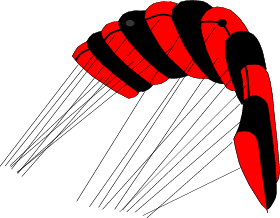 Peter Lynn Kites make a small water-relaunchable parafoil called the Waterfoil which looks rather like this. It's not very expensive, but it's not very user-friendly either. It can be flown with two control lines and a brake line. It is, or was, available in sizes down to 25 square feet or maybe smaller. Very nicely made of spinnaker fabric, it has a lot of thin nylon lines attached to the bottom. There are two small round holes in the leading edge. Inside each hole is an open-ended tube or sock which allows air into the kite but prevents it escaping. If there's enough wind, you can launch it and let it inflate in the air. If there's not quite enough wind, you can inflate it on the ground. About 75 puffs per side unless you have a pump.
Peter Lynn Kites make a small water-relaunchable parafoil called the Waterfoil which looks rather like this. It's not very expensive, but it's not very user-friendly either. It can be flown with two control lines and a brake line. It is, or was, available in sizes down to 25 square feet or maybe smaller. Very nicely made of spinnaker fabric, it has a lot of thin nylon lines attached to the bottom. There are two small round holes in the leading edge. Inside each hole is an open-ended tube or sock which allows air into the kite but prevents it escaping. If there's enough wind, you can launch it and let it inflate in the air. If there's not quite enough wind, you can inflate it on the ground. About 75 puffs per side unless you have a pump.
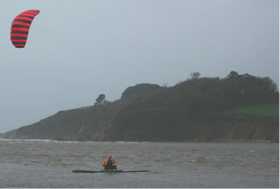 A Waterfoil is a possible solution for kayak sailing, and it's certainly fun trying. Here's your editor's test rig. Both he and it are the right way up, which makes a nice change. However the 25 sq ft Waterfoil needs a Force 3 to fly and in a Force 5 it is capable of dragging a 200 pound man across the beach while seated or lifting a 110 pound woman right off the ground. Apparently the similar HQ Hydra and the Viron Flysurfer are much friendlier than the Waterfoil. Alternatively a small LEI kite intended for training novice kitesurfers may be a better way to power a sea kayak, if you are willing to spend the money.
A Waterfoil is a possible solution for kayak sailing, and it's certainly fun trying. Here's your editor's test rig. Both he and it are the right way up, which makes a nice change. However the 25 sq ft Waterfoil needs a Force 3 to fly and in a Force 5 it is capable of dragging a 200 pound man across the beach while seated or lifting a 110 pound woman right off the ground. Apparently the similar HQ Hydra and the Viron Flysurfer are much friendlier than the Waterfoil. Alternatively a small LEI kite intended for training novice kitesurfers may be a better way to power a sea kayak, if you are willing to spend the money.
Tell us your own experiences and solutions - see Get In Touch.
Sailing a canoe
 A Canadian canoe is wider than a sea kayak and has a flatter bottom. You could say that it is halfway between a kayak and a sailing dinghy. A canoe can carry a small sailing rig without needing a stabilizer.
A Canadian canoe is wider than a sea kayak and has a flatter bottom. You could say that it is halfway between a kayak and a sailing dinghy. A canoe can carry a small sailing rig without needing a stabilizer.
An ordinary touring canoe fitted with a mast, sail, leeboard and rudder can be sailed on sheltered waters, upwind or down. In the illustration, the 2 meter (6 foot) long object is one of the two leeboards. Most canoe sailors use shorter leeboards.
For detailed information, there's an excellent illustrated article by Sam Manning in WoodenBoat magazine for May-June 1978 entitled "Sticks & String". Links to this and many other things can be seen at Craig O'Donnell's other website, Canoe Sailing Resources 2010. See also the website of the Open Canoe Sailing Group.
That's not by any means the only way to sail a canoe. There was a craze in the 19th century for sailing kayaks and canoes, and they developed along two separate routes. The result was a range of dedicated sailing craft for athletic racing, and a range of heavier and wider boats for cruising. There are some seaworthy sailing canoes in North America and Britain, and there are lots in Scandinavia. See Sailing Canoes For Exposed Waters.
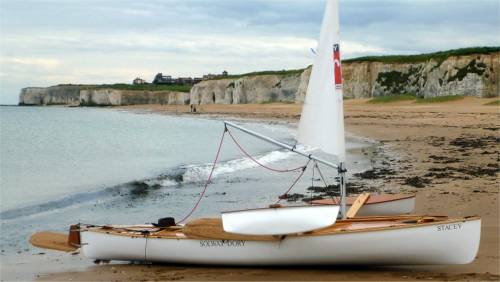 Another solution if you want to have a cruising canoe with only one slippery hull in the water, but the confidence to go out onto exposed waters, is to fit a pair of floats on a crossbeam but well above the waterline. They don't provide stability in normal use but can save you from a swim.
Another solution if you want to have a cruising canoe with only one slippery hull in the water, but the confidence to go out onto exposed waters, is to fit a pair of floats on a crossbeam but well above the waterline. They don't provide stability in normal use but can save you from a swim.
Exposed waters? Well, in 2012 Gavin Millar went 1000 nautical miles round the coast of the UK with this Shearwater sailing canoe from Solway Dory, finishing at Oban in Scotland.
If you prefer relaxed sailing while sitting on the floor of the canoe and facing forward, a Canadian canoe can be fitted with stabilizers to turn it into a miniature trimaran, as with the kayak sailing rigs mentioned above.
Some folding kayaks are almost as wide as a canoe and have a lower centre of gravity because the kayaker sits lower down. They have enough stability to carry a small mast and sail in fine weather. Sailing rigs are available as accessories for folding boats made by Klepper, Grabner and the wider kayaks in the Feathercraft range. See Folding Kayaks.
Making rudders, leeboards & foils
In theory, a rudder, leeboard or Bruce foil should be long and thin (it should have a high aspect ratio). Think of the wing of a sailplane. In practice, for a boat that sails in shallow water it is often better not to make your foils too deep. If you want to be able to sail a foil-stabilized boat right up the beach, you may even opt for foils which are wider than they are tall, as with the SkiSail. See Other Multihulls For Exposed Waters.
Anything you hang into the water will create drag and slow your boat. To minimize drag, the cross-section of a rudder, leeboard or Bruce foil should be carefully shaped. As with an aircraft wing, you want a rounded (parabolic) leading edge and a sharp trailing edge. To get a better idea, have a look at a windsurfer skeg or the fins on a surfboard. Serious racers usually use one of the NACA or Clark cross-sections. For a leeboard or Bruce foil try a Google search on "NACA 0010" or "NACA 009" .
The International Moth sailing dinghy wins the Kayarchy award for the most insane sailing device ever built in large numbers. It looks like an ordinary small racing dinghy until it reaches a certain speed, when its hull rises completely clear of the water using the lift generated by a few yards of NACA 63412, just 4.5 inches wide and half an inch thick. They can go at over 30 knots, and they're not called sailors any more, they're riders. Part of the old UK Moth website was headed VaVaVoom. Nothing to do with sea kayaking but have a look anyway. The international Mothie site is at www.moth-sailing.org. And while we're digressing, check out the Trampofoil, a human-powered water device which doesn't have a hull, floats or any positive buoyancy at all, just foils. www.trampofoil.com.
Leeboards and Bruce foils both need to be stronger than you might think. It is common to read of a home-designed and home-built boat which works very well except that the centerboard or leeboards broke on the first outing.
For some practical advice on quick, strong and easy construction, see two articles from Duckworks Magazine: www.duckworksmagazine.com/06/how to/foils/index.htm and www.duckworksmagazine.com/07/how to/rudder/index.htm
Air tends to get sucked from the surface down the length of surface-piercing foils, which impairs their efficiency. The faster the foil goes through the water, the more this happens. The foils of high speed craft such as windsurfers often have a fence (a horizontal flange) right round the foil, a short distance the surface, to prevent this. The K-Wing shown above has a fence on the foil, although this is not easy to see on a small image.
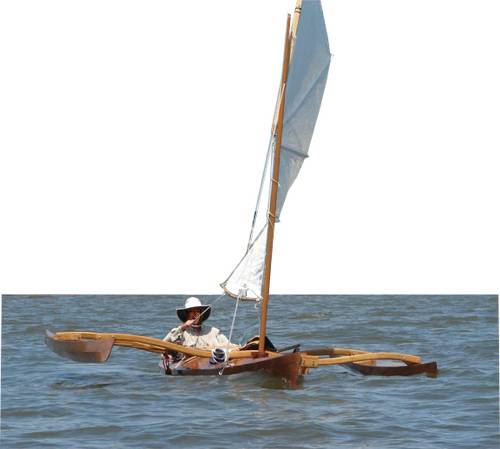



 Getting back to stabilizers, some manufacturers have produced kayaks fitted with a pair of outrigged floats. The red one is about as heavy and complex as these get. It has a pair of long, rigid floats (ama), a pair of long, strong crossbeams (iako), a rudder and centreboard, a fairly tall stiff mast, and a sophisticated sailing rig. It's really a miniature trimaran. If you want to build one, you can get plans from designers like
Getting back to stabilizers, some manufacturers have produced kayaks fitted with a pair of outrigged floats. The red one is about as heavy and complex as these get. It has a pair of long, rigid floats (ama), a pair of long, strong crossbeams (iako), a rudder and centreboard, a fairly tall stiff mast, and a sophisticated sailing rig. It's really a miniature trimaran. If you want to build one, you can get plans from designers like  It is possible to substitute hydrofoils for floats.
It is possible to substitute hydrofoils for floats.  To make it light and small enough to fit on the rear deck when not in use, the K-Wing had a foil on only one side and the foil had no significant flotation. Flotation is definitely worth having because in the chaotic conditions of the boundary between air and water, a Bruce foil will eventually either sink or get plucked up out of the water. The problem in a kayak is finding a way to stow a foil if it's fitted with positive buoyancy.
To make it light and small enough to fit on the rear deck when not in use, the K-Wing had a foil on only one side and the foil had no significant flotation. Flotation is definitely worth having because in the chaotic conditions of the boundary between air and water, a Bruce foil will eventually either sink or get plucked up out of the water. The problem in a kayak is finding a way to stow a foil if it's fitted with positive buoyancy.  A conventional single-surface sail (A) functions like a kite or hang-glider wing.
A conventional single-surface sail (A) functions like a kite or hang-glider wing.  Peter Lynn Kites make a small water-relaunchable parafoil called the Waterfoil which looks rather like this. It's not very expensive, but it's not very user-friendly either. It can be flown with two control lines and a brake line. It is, or was, available in sizes down to 25 square feet or maybe smaller. Very nicely made of spinnaker fabric, it has a lot of thin nylon lines attached to the bottom. There are two small round holes in the leading edge. Inside each hole is an open-ended tube or sock which allows air into the kite but prevents it escaping. If there's enough wind, you can launch it and let it inflate in the air. If there's not quite enough wind, you can inflate it on the ground. About 75 puffs per side unless you have a pump.
Peter Lynn Kites make a small water-relaunchable parafoil called the Waterfoil which looks rather like this. It's not very expensive, but it's not very user-friendly either. It can be flown with two control lines and a brake line. It is, or was, available in sizes down to 25 square feet or maybe smaller. Very nicely made of spinnaker fabric, it has a lot of thin nylon lines attached to the bottom. There are two small round holes in the leading edge. Inside each hole is an open-ended tube or sock which allows air into the kite but prevents it escaping. If there's enough wind, you can launch it and let it inflate in the air. If there's not quite enough wind, you can inflate it on the ground. About 75 puffs per side unless you have a pump. A Waterfoil is a possible solution for kayak sailing, and it's certainly fun trying. Here's your editor's test rig. Both he and it are the right way up, which makes a nice change. However the 25 sq ft Waterfoil needs a Force 3 to fly and in a Force 5 it is capable of dragging a 200 pound man across the beach while seated or lifting a 110 pound woman right off the ground. Apparently the similar HQ Hydra and the Viron Flysurfer are much friendlier than the Waterfoil. Alternatively a small LEI kite intended for training novice kitesurfers may be a better way to power a sea kayak, if you are willing to spend the money.
A Waterfoil is a possible solution for kayak sailing, and it's certainly fun trying. Here's your editor's test rig. Both he and it are the right way up, which makes a nice change. However the 25 sq ft Waterfoil needs a Force 3 to fly and in a Force 5 it is capable of dragging a 200 pound man across the beach while seated or lifting a 110 pound woman right off the ground. Apparently the similar HQ Hydra and the Viron Flysurfer are much friendlier than the Waterfoil. Alternatively a small LEI kite intended for training novice kitesurfers may be a better way to power a sea kayak, if you are willing to spend the money.  A Canadian canoe is wider than a sea kayak and has a flatter bottom. You could say that it is halfway between a kayak and a sailing dinghy. A canoe can carry a small sailing rig without needing a stabilizer.
A Canadian canoe is wider than a sea kayak and has a flatter bottom. You could say that it is halfway between a kayak and a sailing dinghy. A canoe can carry a small sailing rig without needing a stabilizer.  Another solution if you want to have a cruising canoe with only one slippery hull in the water, but the confidence to go out onto exposed waters, is to fit a pair of floats on a crossbeam but well above the waterline. They don't provide stability in normal use but can save you from a swim.
Another solution if you want to have a cruising canoe with only one slippery hull in the water, but the confidence to go out onto exposed waters, is to fit a pair of floats on a crossbeam but well above the waterline. They don't provide stability in normal use but can save you from a swim.